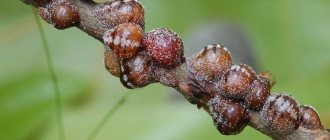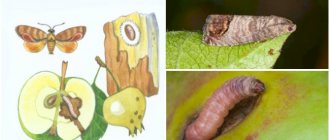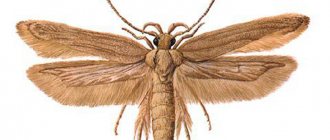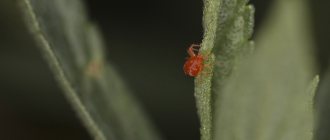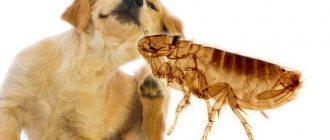A familiar situation: you bit into an apple (which had a black hole in it), and there was a worm in it? In fact, this is not a worm, but a larva (caterpillar) of the codling moth.
Next, you will learn what methods exist to combat this malicious pest on apple trees and other fruit trees, the same “worm” that lives in wormy apples.
Codling moth on an apple tree. Features of the insect and signs of presence
Codling moth on an apple tree: photo of the pest
Abundant apple tree blossoms are quite a beautiful and fragrant sight. If this vision is accompanied by the numerous presence of a butterfly, and if you look closely, you find microscopic holes on the ovaries, you can firmly say that you have a problem. The apple tree was attacked by a moth.
An additional sign is fallen fruits that have just begun to form. If the fruit is cut, you can find small trenches-gnawed, the seed chamber of the apple is also damaged. All doubts disappeared. The codling moth is in full activity.
The eastern codling moth is one of the dangerous quarantine enemies of the apple tree. In southern countries, up to the fifth generation can develop, and up to seven larvae can be located in one apple. This amount can destroy 80% of the crop in a fairly short period of active action.
The entire European part of Russia is suffering from a butterfly invasion. Far East, Siberia, Ukraine, Caucasus and several other countries. The greatest activity of the codling moth: Russia, the Ukrainian zone, the mountainous Crimea.
Atmospheric phenomena, such as prolonged drought, can greatly affect the number of butterflies. Heat can cause mass caterpillar death, almost 100%, provided that the air humidity has dropped to 30%.
Important point! Particularly noticeable is the widespread destruction due to the vagaries of the weather in the dry and fairly hot month of July, until the caterpillar hits the fruit. This destruction is observed in the northern regions and non-black earth regions.
What is a codling moth?
Codling moth on an apple tree: photo of the pest
Let's look at the external features of the codling moth. A thickish, small worm, a caterpillar, gray dots located on a reddish-pink body. If you check by touch, you will not find any hint of hairiness or pubescence.
The head is brownish-red. Due to its color, the caterpillar looks very bright and it is difficult for it to hide on the monochromatic greenery of the tree. One external sign is the presence of legs with tangible claws. In the back there are fake legs, but there are claws there too. The total length of the caterpillar does not exceed two centimeters.
Let's look at the life cycle of a butterfly step by step:
- active years of adults, butterflies;
- pairing;
- the moment of laying eggs of the codling moth in secluded places;
- appearance of first-year caterpillars;
- search for food, development of fruit, apple;
- fruit feeding process;
- the period when caterpillars leave fruits for the pupation process.
Codling moth on an apple tree: methods of control
Codling moth on an apple tree: photo of the pest
Don't miss an important moment!
The time between these stages is very short, all development processes are quite dynamic. In each climate zone, gardening zone, these terms are different. It is worth taking into account such dynamics of development and not delaying the response. The number of generations that can survive on one apple tree also varies in number. Depends on the place, region of residence.
In the northern regions, the codling moth on an apple tree can grow up to two generations per season. The southern climate is most favorable for butterfly breeding. Therefore, three generations of caterpillars can grow in such a zone. The most comfortable living of the eastern species of butterfly is observed in the southern zones of Russia. The number of generations in such conditions reaches a maximum of five generations.
The moment of the appearance of the first generation in apple orchards in the northern regions falls during the period of formation of small apple fruits. Around the last days of May and until the end of June. In the southern regions this moment comes much earlier. The activity of caterpillars can be observed in the first days of May.
By the onset of winter, adult individuals of 4-5 generations remain. White silky cocoons spend hibernation in their warm “blankets”. Although this may only be the second or third generation, this fact is much less common.
The codling moth attacks almost all varieties and types of apple trees. There are currently no completely resistant varieties. It was noted that the most favorite treat for the codling moth are fruits that are sweeter, more tasty, and intended for fresh consumption, making jams, purees, and preserves. Juicing varieties are less affected.
There are several methods to combat the codling moth on an apple tree:
- agrotechnical;
- chemical;
- mechanical;
- biological.
Worth paying attention! All available methods must be used simultaneously. This is the only way to completely destroy even the slightest presence of the codling moth.
Trim the apple tree in a timely manner. Feed with essential nutrients. Proper watering and regular care of the soil around the tree. All such significant moments help the apple tree to resist the slightest or large-scale attacks of the pest.
As a result of unstable frosts, damage to the tree by hail, or, even worse, overfed with organic matter, the apple tree becomes very accessible to the active actions of the caterpillar butterfly.
The simplest method, and most importantly the safest, is to diversify the crops in your garden. This attracts a lot of attention from various natural predators, which, in turn, are the codling moth’s worst enemies.
With their activities they are able to destroy almost 50% of caterpillars. The result is natural destruction, without the use of chemicals, which is still completely safe for humans and the environment. It also serves as a preventive measure against codling moths. It is necessary to create conditions in the garden under which the entire life cycle of the pest butterfly becomes almost impossible or is partially disrupted, which again reduces the number of moths on the apple tree.
Life cycle
To turn into a butterfly, the caterpillar goes through several periods of development. Adults fly out at dusk to reproduce. This stage occurs when the trees are flowering, so the process can last 45-60 days. One female is capable of laying up to 120 eggs, from which voracious larvae appear after 3 days.
During the season, 2 generations grow in cold climates, 3 in temperate climates and up to 5 in the south. The first specimens hatch from late May to early June and consume up to 25% of the harvest. The second wave is more dangerous: the caterpillars eat up to 80% of the apples. The pest phase lasts 2-6 weeks, then the young pupate into a light cocoon and go to winter.
The larvae hide in the bark, in plant debris under a tree, in the grass. They wake up in the spring at an air temperature of +10 °C and lay eggs after 3 days. The eastern codling moth is the most dangerous species, breeding 5 generations of young during the season. Insects die en masse under conditions of drought and a decrease in humidity levels to 25%.
Why does the codling moth survive in your garden?
Codling moth on an apple tree: photo of the pest
What helps the butterfly maintain its vital functions and activity on the apple tree for a long time, almost five generations? The first thing that can be highlighted is their large numbers, reproduction within one season by generations, and the multiple presence of secluded places for comfortable wintering.
There can be a huge number of places where the codling moth hides on an apple tree during the winter:
- when the garden is quite old, cocoons have the opportunity to hide in the cracked bark. The height of the laying places above the soil is not higher than 60 centimeters;
- some pupae overwinter in the soil directly under the apple tree;
- places where you store humus, various supports for tall trees. Possible buildings located near trees. Even just shelters located throughout your entire site;
- if the garden is young enough, the caterpillar can overwinter close to the root system, no deeper than 8 centimeters.
- container for storing apples. Getting into such places occurs with the help of fruits, where the caterpillar has become accustomed while still active.
Appearance (morphology)
The adult parasite is a gray butterfly with a thick body and feathering on the limbs. The wingspan reaches 20 mm. The inconspicuous color allows them to perch unnoticed on trees and lay eggs. “Parents” do not harm trees, but their appearance in the garden warns of future invasion.
Codling moth caterpillars are small worms (up to 2 mm in length), the thick body of which is bright pink with gray spots. The pest has a red-brown head and a shield on the chest with chitinous protection. Movement and stability on any surface are ensured by short limbs with walking claws. During the winter, the larva pupates under the bark, in the soil.
How to fight the codling moth on apple trees using chemicals?
Treatment of apple trees against codling moth: photo
Prevention is a good way to avoid the appearance of codling moths. But efficiency is only 30%. It is necessary to use the method of spraying with chemicals of synthetic origin. These substances are based on organophosphorus compounds. In some cases, neonicotinoids and pyrethroids are used.
Next, we will consider in more detail the timing and methods of treating an apple tree when the codling moth appears, as well as to prevent its appearance. Chooses methods that do not cause much harm to the crop and the tree in particular.
Fitoverm is a complex of effects, absorbed through the outer shell after spraying the apple tree. As a result of the pest’s absorption of fruits treated with chemicals, the poison enters the body, affecting the nervous system, paralyzing it, which leads the pest to inevitable death.
Focus on the fact that all substances based on “aversectin-C” have an effect of no more than 480 hours, and the use of such drugs during the period when the apples are already filled with juice is strictly prohibited!!!
A question arises when choosing drugs. Is it possible to use herbicides safely? It is safe to say that this is a complete scam by the manufacturer. These substances are not capable of saving your garden. But there is a huge chance of destroying your favorite apple trees.
Herbicide substances are a toxic substance used to destroy weeds in fields and plots. The caterpillar cannot be harmed to any degree.
Take advantage of the advice!!! Always purchase all drugs for pest and disease control only in specialized stores, if you have all the certification, and only from a trusted manufacturer.
Let's talk about compounds that can destroy caterpillars, but leave your long-awaited harvest intact. The most effective pesticides, which are purchased in a specialized store and are excellent in the fight against codling moths, can be emphasized:
- Karate-Zeon, Kinmiks, Sumi-alpha, Lambda;
- Aktellik, Pirimifos;
The influence of these passes through the system: Konfidor, Talstar, Fastak, Tanrek, Taran. The drugs come from neonicotinoids. Pyrethroids are specially derived substances. Apples can only partially penetrate the leaf cover and are perfectly retained by the cells on the surface. The use of the above substances guarantees a 100% impact on the pest.
The most important!!! The preparations must be used strictly one month before the fruits are fully ripened.
How to treat an apple tree against codling moth? useful video
Mixed insecticides
For several years, only one of the available poisons was used? Was there no system followed during processing? The question arises, how to treat cultivated trees once again and carry out such a procedure in accordance with all the rules for the use of pesticides?
It is recommended to use a mixed chemical composition. It is advisable to purchase ready-made mixtures in the store; preparing them yourself is quite painstaking work. And any mistake can lead to loss of harvest or harm the human body after eating processed apples.
So, the recommended mixtures:
- Lambda-cyhalothrin + Imidacloprid;
- Chlorantraniliprole + Thiamethoxam.
Well-known compounds: Dichlorvos, Karbofos, Fufanon. All of the compounds listed are quite persistent and toxic. They are leaders in the fight against codling moths. Their consumption is insignificant for a certain area of treatment, and the temporary impact on the codling moth is quite high.
Spraying timing
Protection of fruit crops is a set of works that are carried out during the growing season.
To better destroy parasites, you need to adapt to the life cycles of pests.
The number of treatments depends on the age of the tree. For young people, 8 procedures are enough, and for those over 15 years old, 10 events are enough.
in spring
The first spraying is carried out on dormant buds at a temperature within +5 °C. They first do sanitary pruning and clean the bark of lichens and diseases. To combat wintering forms use:
- Fufanon;
- Aktellik;
- Intavir.
During the green cone period, systemic chemicals are needed - Aktara or Fastak. Before the buds open, future fruits are protected with Enzhio or Tiovit Jet.
During flowering, any activities are prohibited. If there is a risk of mass invasion, then folk and biological remedies are used.
After flowering
After the petals fall, synthetic mixtures of poisons are used that kill parasites within 24 hours. During the summer of butterflies, the chemicals Dimilin and Herold will help prevent the first wave of caterpillars. Females lay eggs in a poisoned plant, and the hatched larvae die instantly.
During the period of fruit ripening
At the end of June, the second generation of moths appears, so at least 3 procedures will be required. To prevent infection, trees are sprayed immediately after the petals fall. Apple trees with ovaries are treated again 10 days after flowering. The last action against caterpillars is carried out 3 weeks before harvest.
in autumn
At the end of the season, the plants are prepared for wintering. In the garden, preventive procedures are carried out against parasites that hide in the bark, soil and on branches. Carefully clean and dig up areas in the root circle, and carry out sanitary pruning. In autumn they spray with Fufanon, Karbofos or Intavir.
The codling moth is a dangerous caterpillar that can reduce the yield of apple trees by 80%. Timely and regular measures will provide long-term protection throughout the season. For the product to work, you need to choose the right type and method of treatment in the garden.
Apple codling moth: how to spray trees against the pest
Spraying an apple tree against codling moth: photo
It is advisable to spray an apple tree against codling moths using the shower method. Special devices and industrial sprayers will help with this. The shower is very tightly capable of covering the entire volume of the green cover of the apple tree, completely all the shoots and even the rudiments of the apples. The consumption of the drug is significantly less.
Wind gusts do not spread the drug solution to neighboring plants, and the risk of poison getting into the neighboring crop is reduced significantly.
What time to spray an apple tree against codling moth
Every gardener simply must know how and especially during what periods to spray against codling moths. Each region has different time frames. Even the spring period occurs differently every year.
It simply won’t be possible to set any time frames, because the definition of each period occurs differently, on the spot. Just don’t miss the moment, for example, during the butterfly’s active summer. It also depends on the number of individuals and the speed of spread.
Spring!
During this period, it is recommended to use organophosphates. The pest is completely exterminated at the birth stage. The caterpillar is simply physically unable to reach the fruit at this age, so the result of spraying will be almost 100%.
It is worth using: Admiral, Zolon, Calypso, Chlorpyrifos and a number of other products. A group of drugs that can regulate the development and growth of insects. The adult begins to lay eggs on the already poisoned surface, so the caterpillar has no chance of survival.
You can also use the poisonous compound Chlorantraniliprole + Thiamethoxam;
Summer: the crop has bloomed, fruits have set, mass ripening begins
During the ripe period, apples should never be treated with chemicals. At the moment, pheromone traps, belts, biological products, and decoctions of herbs dangerous to the caterpillar come to the rescue. The method is used for summer and autumn ripening apple trees.
Important!!! No chemicals or synthetic poisons;
Autumn time!
How beautiful she is. The long-awaited harvest has been harvested. Mass leaf fall begins. The time has come to do a complete, fruit-safe, garden treatment. Any remedy can be used. Spray the crown of the apple tree with chemicals. Old bark from the trunk and branches must be removed using special garden scrapers. It is not advisable to carry out all these procedures before the autumn period.
The first stage of spraying at the beginning of the growing season for an apple tree is early spring and early summer. Before abundant flowering begins. This process consists of two stages: before and after flowering. The period ends after fruit set.
How often do you need to spray? Places where at least two generations of codling moths form on winter varieties of apple trees must be treated at least 4 times. Summer varieties require less treatment, no more than two sprays.
In those regions where the butterfly can breed up to three generations, experience recommends spraying summer apples five times, and winter varieties should be sprayed 7 times.
Daily time for treating apple trees against codling moths
It is advisable to choose cloudier weather; there should be no wind at all. Carry out the procedure in the early hours or after sunset. Daytime changes in weather can reduce the effects of the poison. Windy weather increases the risk of pesticides spreading to neighboring crops and areas.
If we take the south of Ukraine, the Lower Volga region, the Stavropol Territory or the Rostov region, then they have their own time frames for processing apple trees. Flowering ends and only after 13-15 days can it be sprayed. The first caterpillars have appeared, count down approximately 18 days and begin processing the wood.
Northern Caucasus, Krasnodar Territory: 11 days after the mass flowering of apple trees - do the first stage of processing. The second period is 21 days after the first. If you find caterpillars in falling apples, start the third stage of processing. The fourth period is on the twentieth day after the third. Four stages are enough.
But if a situation of mass caterpillar activity arises, perform the fifth treatment; this applies only to winter varieties.


